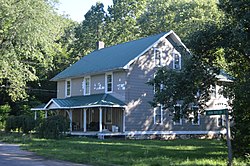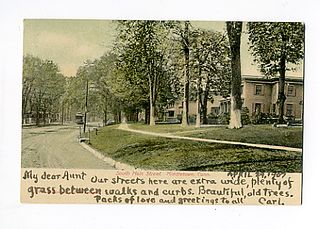
Located in Middletown, Connecticut, the Middletown South Green Historic District was created to preserved the historic character of the city's South Green and the historic buildings that surround it. It is a 90-acre (36 ha) historic district that includes a concentration of predominantly residential high-quality architecture from the late 19th century. It was listed on the National Register of Historic Places in 1975.
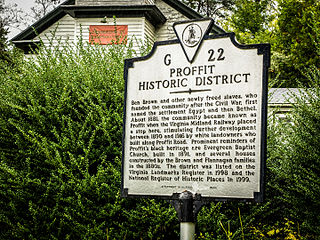
The Proffit Historic District is a national historic district located at Proffit, Albemarle County, Virginia. It encompasses 26 contributing buildings and 3 contributing sites in the historic center of Proffit. Notable buildings and sites includes Evergreen Baptist Church, the Proffit Station Master's House, remains of the first Proffit Post Office, the Proffit Road Bridge, and several houses built by African-American families as far back as the 1880s.
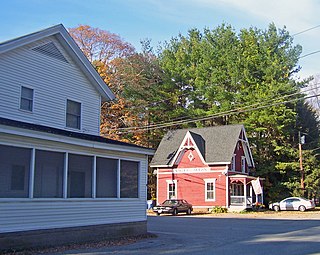
The Sharon Valley Historic District is located around the junction of Kings Hill, Sharon Valley and Sharon Station roads in Sharon, Connecticut, United States. It is a small community that grew up around an iron mining and refining operation during the late 19th century, the first industry in Sharon.

The Brierfield Furnace, also known as the Bibb Naval Furnace and Brierfield Ironworks, is a historic district in Brierfield, Alabama. The district covers 486 acres (197 ha) and includes one building and nine sites. It was listed on the National Register of Historic Places on November 20, 1974. The district is encompassed by Brierfield Ironworks Historical State Park.

Clifton Historic District is a national historic district located at Clifton, Fairfax County, Virginia. It encompasses 62 contributing buildings, 1 contributing site, and 1 contributing object in the town of Clifton. They include 53 residences, 3 churches, 4 commercial buildings, and 2 local government buildings mostly built between 1880 and 1910. Notable buildings include the Clifton Presbyterian Church (1871), Clifton Baptist Church (1912), Clifton Hotel (1869), the Mayhugh Tavern, the Ford House, the Cross House, Buckley Brothers Store, the M. M. Payne House (1903), and "Red Gables" (1908).

The Farm is a historic home located at Rocky Mount, Franklin County, Virginia. The house was probably built during the late-18th century, expanded in the 1820s, and heavily remodeled in the Greek Revival style around 1856. It is a two-story, frame dwelling sheathed in weatherboard with a single-pile, central-passage-plan. It features a two-story, projecting front porch. Later additions were made in the late-19th and early-20th century. Also on the property are a contributing one-story brick slave quarters/summer kitchen and the site of a farm office marked by a stone chimney. The house was used as the ironmaster's house for the nearby Washington Iron Furnace.

Washington Iron Furnace is an historic iron furnace, located in Rocky Mount, Franklin County, Virginia. The granite furnace was built around 1770, measures 30 feet on its south face, and was listed on the National Register of Historic Places in 1973. Now one of the best preserved furnaces in Virginia, it was built against the side of a hill so iron ore, charcoal and limestone could be brought by wagon and dumped into the top of the furnace, although the original cart road and ten-yard-long bridge leading to the top no longer exist.

Old Forge Farm, also known as Zane's Furnace, Stephens Fort, and Marlboro Iron Works, is a historic home and farm located near Middletown, Frederick County, Virginia. The original section dates to the 18th century. The house is a two-story, asymmetrical, three-bay, limestone dwelling with a two-story addition connecting the main house to a one-story former summer kitchen. Also on the property are the contributing 18th century hexagonal ice house of unusual design, an early 20th-century root cellar, privy, and shed. The property was first known as Stephen's Fort, built by Lewis Stephens, son of Peter Stephens, for protection during the French and Indian War. Sold in 1767 to Isaac Zane, whose Zane's Furnace was a major manufacturer of munitions for the Continental Army. Grist mill operations continued into the 1950s.
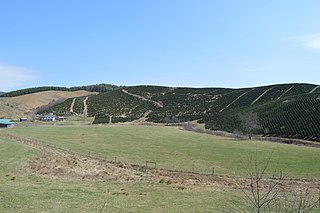
Spring Valley Rural Historic District is a national historic district located near Fries, Grayson County, Virginia. The district encompasses 184 contributing buildings, 3 contributing sites, and 1 contributing object in the wooded and agricultural northeastern corner of Grayson County. It includes mostly frame or log structures, with a few brick buildings, and several well-preserved examples of early-19th century log dwellings still in use. Notable buildings include the Knob Fork Primitive Baptist Church, William Bourne House "Walnut Hill", Austin King House, Tomlinson House, O'Donnell Place, Ephraim Boyer House, John Fielder Farmhouse, Ebenezer Methodist Church and Cemetery, Spring Valley Academy, Glenn Cornett House (1904), and Phipps Bourne Farmstead (1909). Located in the district is the separately listed Stephen G. Bourne House.

Eastville Historic District is a national historic district located at Eastville, Northampton County, Virginia. The district encompasses 315 contributing buildings, 7 contributing sites, and 4 contributing structures in the county seat of Northampton County. The historic district contains a wide variety of residential, commercial, governmental, educational, social, religious, and funerary resources dating from 1731. Notable buildings include the courthouse (1731), clerk's office, Park Hall, Eastville Inn, Ingleside, Hickory Grounds, Maria Robins House, the Old Brick Store, Abdell Funeral Home, Edward Holland House, and Ailworth Hall. Also located in the district are the separately listed Cessford, Eastville Mercantile, and James Brown's Dry Goods Store.

Bowman–Zirkle Farm, also known as the Isaiah Bowman Farm, is a historic home and farm and national historic district located near Edinburg, Shenandoah County, Virginia. The district encompasses seven contributing buildings and three contributing structures. The farmhouse was built in 1879, and is a two-story, three bay, frame I-house dwelling with an integral wing. The remaining contributing resources are a 19th-century log-and-frame tenant house, a summer kitchen, frame meat house, a large bank barn ; a barn shed, a second bank barn, a frame granary, a wood-stave silo, and a large, two-story chicken house.

Saltville Battlefields Historic District is a historic American Civil War battlefield and national historic district located around Saltville, in Smyth County and Washington County, Virginia. The district includes 3 contributing buildings, 31 contributing sites, 4 contributing structures, and 1 contributing object near Saltville. It encompass the core areas of two battles, fought on October 2 and December 20, 1864, known as the Battle of Saltville I and Battle of Saltville II, where Confederate and Union forces contested control of the South's most important salt production facilities. Notable resources include the sites of salt furnaces, Well Fields, Fort Statham, Lover's Leap Defenses, Saltville Gap Overlooks, Mill Cliff gun emplacements, Fort Breckinridge, Fort Hatton, Sanders’ House/Williams Site Battlefield/field hospital, William A. Stuart House, and the Elizabeth Cemetery.

Riverton Historic District is a national historic district located at Front Royal, Warren County, Virginia. The district encompasses 66 contributing buildings and one contributing site in the town of Front Royal. It is a primarily residential district with buildings dating from the mid-19th century and including a diverse collection of building types and architectural styles. Notable buildings include Lackawanna (1869), the Old Duncan Hotel, the Riverton United Methodist Church (1883-1890), Dellbrook, the Carson Lime Company worker's houses, and the Old Riverton Post Office and Grocery. Located in the district and separately listed is Riverside.

Sanders Farm is a historic home and farm located at Max Meadows, Wythe County, Virginia. The Brick House was built about 1880, and is a two-story, "T"-shaped, Queen Anne style brick farmhouse. It features ornamental gables and porches. Also on the property are the contributing cold frame with a stepped front parapet, a vaulted stone spring house, a one-story brick servants quarters, a cinder block store with an upstairs apartment and an accompanying privy (1950s), a frame vehicle repair shop, a stone reservoir (1880s) two corn crib, a frame gambrel-roofed barn, a one-story tenant house, stone bridge abutments, and the site of the Hematite Iron Company Mine, a complex of rock formations and tram line beds.

Foster Falls Historic District is a national historic district located near Max Meadows, Wythe County, Virginia. The district encompasses 12 contributing buildings, 2 contributing sites, and 3 contributing structures in the village of Foster Falls. They are primarily industrial and commercial buildings and structures built in the late-19th century. They include the iron furnace stack, the rail bed and frame railroad passenger station, a general store building, and a combination gristmill/sawmill. The district and includes the Foster Falls Hotel, a late-Victorian style brick building. The hotel property includes two brick dependencies associated with an orphanage that occupied the hotel building beginning in 1938. It now serves as the headquarters of the New River Trail State Park.
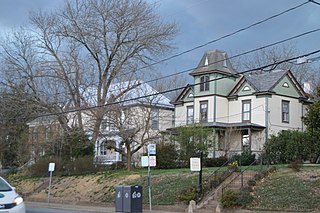
Ridge Street Historic District is a national historic district located at Charlottesville, Virginia. The district encompasses 32 contributing buildings in a four block residential section of the city of Charlottesville. It was primarily developed after the 1870s-1880s. Notable buildings include the Gleason House (1890s), Fuller-Bailey House (1892), Clarence L. Hawkins House (1915), Bibb-Wolfe House, Gianny-Bailey House (1895), Walters-Witkin House, and Colonel John B. Strange House (1855).

Wertland Street Historic District is a national historic district located at Charlottesville, Virginia. The district encompasses 25 contributing buildings in a two block residential section of the city of Charlottesville. It was primarily developed starting in the 1880s. Notable buildings include the Wertenbaker House, McKennie-Miller House, Ward-Brown-Gay House (1889), Marshall-Dabney-Cubbage House (1892), Bryan-Stallings House (1900), and Watson House (1905).

Centreville–Fentress Historic District is a national historic district located at Chesapeake, Virginia. The district encompasses 24 contributing buildings and 10 contributing structures in a rural farming community that developed a small commercial core. It was developed starting in the 1880s, with the addition of the Norfolk and Elizabeth City Railroad link to the Albemarle and Chesapeake Canal. Notable resources include the Fentress House, Colonial Revival style Centerville Baptist Church (1925), New Burfoot House (1925), Queen Anne style George Jackson House (1890), the Norfolk and Elizabeth City, NC Railroad Tracks, and a 1920 commercial building.

The West Broad Street Commercial Historic District is a national historic district located at Richmond, Virginia. The district encompasses 20 contributing buildings built between about 1900 and the late 1930s. Located in the district is the Forbes Motor Car Company (1919), Harper-Overland Company building (1921), Firestone Building (1929), Engine Company No. 10 Firehouse, and the Saunders Station Post Office (1937). The majority of the buildings are two-to-four stories in height and are composed of brick with stucco, stone and metal detailing. Located in the district is the separately listed The Coliseum-Duplex Envelope Company Building.
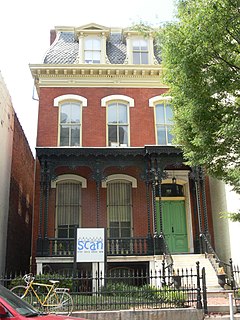
Joseph P. Winston House, also known as the Winston House, is a historic residence in Richmond, Virginia. It was built in 1873-1874 for wholesale grocer Joseph P. Winston, and is a 2 1/2-story, three bay, brick residence. It features a half-story, ogee-curved mansard roof with black slate shingles. It also has an elaborate cast-iron front porch and original cast-iron picket fence with gate. Also included is the adjacent Richmond Art Company Building. It was designed in 1920 by prominent architect Duncan Lee, and is a three-story, stuccoed brick building in a Spanish-Mediterrean Revival style.
